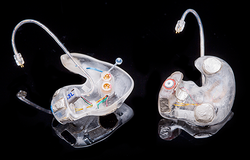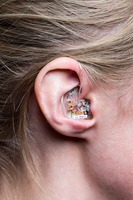Numerous electrodes on the head are currently necessary to achieve sufficiently high-quality data when recording the pattern of electrical activity in the brain. However, researchers at Aarhus University have developed a small ear computer that can pave the way for completely different applications of EEG.

Researchers have been able to present the first version of a miniature appliance that is capable of measuring electrical activity in the brain through the ear. This enables them to bring EEG-monitoring out of hospital labs and into everyday life.
Electroencephalography (EEG) is far from being a new technique. For decades, EEG has been used to measure electrical activity in the brain in a number of diagnostic contexts, for example in connection with the investigations of epilepsy and sleep disorders, or to localise tumours.
Using a large number of small electrodes placed on the patient’s scalp, it is possible to measure electrical brain signals for a limited period of time in laboratories or neurophysiology departments.
With the help of extremely advanced data processing, it is now also possible to not only study neurological disturbances, but also to acquire insight into normal mental conditions such as levels of concentration, intentions or feelings.
Out of the laboratory and into everyday life
The potential of the technology is enormous. EarEEG can be integrated into devices that can be used in everyday life situations outside the laboratory, and this provides a paradigm shift as it enables researchers to decode the signals of the brain in natural settings over extended periods of time.
Professor (Docent) Preben Kidmose, who is one of the world’s leading experts in the measurement of EEG through the ear, explains:
“In the long term, EEG measurements may become very important in our day-to-day lives. The entire field involved in studying how humans and electronic devices interact is undergoing major changes. Once this technology becomes fully available for use outside the laboratory for extended periods of time, we’ll all notice the difference,” he says.
Today, it is already technologically possible to establish direct communication between the brain and different computer-controlled devices.
“We’ve seen some of the first far-reaching examples of how EEG can be used in brand new ways. When a lame woman in the USA can control the computer mouse with her thoughts, or when she drinks her coffee using a robot-controlled arm merely by thinking of the physical movement, it’s because her brain signals are registered and translated to computer instructions,” he continues.
Discreet measurement through the ear
According to Professor (Docent) Kidmose, neuro-engineers have long been researching how signals from the brain can be recorded non-invasively, with sufficient high quality, and in a manner that is discreet and does not disturb the person being investigated.
This is a large, international research field with the common goal to convert conventional EEG systems used in laboratories to new, discreet wearable systems.
At Aarhus University, researchers have specialised in measuring EEG in the ear, and so far this appears to be a promising method.
“In research contexts, it would be valuable to carry out EEG studies over extended periods of time without the test subjects being affected by the measuring equipment. It would often be a great advantage to study brain activity for longer periods of time without interruptions and outside the laboratory or clinic. Our results indicate that EarEEG is an attractive method as it is user-friendly, discreet and comfortable,” says Preben Kidmose.



EEG in new contexts
The ear technology paves the way for using EEG in completely new contexts. Within the clinical field, for example, it will thus be possible to use EarEEG devices to monitor mental and neurological conditions, to optimise therapeutic treatments, or to obtain neuro feedback. As far as healthy individuals are concerned, it will be possible to use the technology to monitor stress loads and sleep, or for simple forms of controlling electronic devices in the home by means of thought.
Last year, researchers at Aarhus University received a major grant that enabled them to develop a new form of EEG technology suitable for measurement through the ear.
The first early prototype, which is no larger than an earplug, is already available. According to the plan, the small device will use three tiny electrodes and a micro-computer that can interpret the activity of the brain. It looks a bit like a normal modern hearing aid and is almost invisible in the ear canal. Processing the signals and the analogue electronics uses very little energy so the researchers are not dependent on new battery technology.
The dream of the pure signal from the brain
On the other hand, new knowledge is required to develop the optimal electrode technology to capture the faint signals from the brain. This includes both material technology for the electrodes, analogue electronic instrumentation for measuring the signals, and comprehensive studies of physiological artefacts and the electric field lines from the brain in order to determine the optimal electrode configurations.
This is the view of Simon Lind Kappel, a PhD student at Aarhus University who is working on this very topic.
“The design of the electrode is one of our main challenges. What is the best possible position of the measuring points? And how do we identify and diminish the electrical activity produced by movements of the head or jaws, for instance, so we’re left with a signal from the brain that is as clear as possible?” he says.
The way ahead is anything but straightforward and involves repeated laboratory tests.
“We’re working systematically with test subjects in the laboratory. We ask them, for example, to clench their jaws or make controlled movements with their heads. That way we’re able to describe the different noise components and thus optimise the electrode technology so that the signal we measure is as pure as possible,” says Simon Kappel.
The initial design of the device for measuring brain activity through the ear looks promising, and the researchers expect to obtain the same quality data as is currently produced by traditional EEG measurements.
Better treatment of epilepsy
The researchers are currently working on using the EarEEG technology to warn diabetic patients of impending hypoglycaemia. In the coming years, they will also investigate how the technology can be used for people with epilepsy. The aim is to make the ear computer’s data quality so good that it can provide the same clinical information as what can be achieved using current technology where patients are monitored over a period of several days in hospital.
“We’d like to show that we can monitor epileptic patients in their daily environment over time and with good data quality. This will save the patients from long and tedious investigations in hospital, and it provides us with a unique opportunity to learn much more about the disease at the same time,” says Preben Kidmose.
The researchers will use the EarEEG technology to gain a more detailed understanding of epilepsy and the neurological variations in their seizures, thereby providing better conditions for tailoring treatment and controlling medication dosages for individual patients.
The method for measuring brain activity is interesting in a considerable number of other diagnostic contexts – such as psychological disorders – where the importance of neurology is not completely understood today.